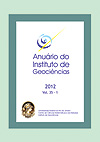Geoutouristic potential of Ibitipoca'S Park, southeastern of Minas Gerais State
DOI:
https://doi.org/10.11137/2012_1_112_122Abstract
The Ibitipoca Mountain is a spectacularly morphostructural feature located between the Santa Rita do Ibitipoca and Lima Duarte cities, southeast Minas Gerais State, between the Parallel 21º38' and 21º44', and Meridians 43º50' and 44º00'. In this environment, was created in 1973 Ibitipoca State Park by Forest Institute of Minas Gerais State, which protects an area of 1,488 ha, with higher altitudes ranging from 1784 m, for the Morro da Lombada and 1722 m of Pico do Pião. This natural feature represents a great declivity of the Serra da Mantiqueira widely flattened with a plateau in the north portion, and a devastated south topography. In the geological context, Ibitipoca Mountain consists mainly of quartzites and coarse grain size, interspersed with layers of fine micaceous quartzites and garnet-sillimanite-biotite schist. The sediments that filled the original sedimentary basin have been metamorphosed in amphibolite facies, and deformed in a compressive tectonic regime resulting from an evolving nappe folding type, with the subsequent development of systems of faults and shear zones of high angle. The result of this tectonic event in sedimentary transitional continent-ocean, associated with erosion action, provided the development of fifteen wonderful and unique caves in quartzites, specially the Bromelias Cave with more development. The geomorphology can be summarized by the occurrence of escarpment plunging toward the river valleys and of Rio do Salto and Córrego da Mata, controlled by major tectonic folding that affected the metasedimentary rocks. The relief of the Ibitipoca Mountain present ruiniform forms, lapies and small valleys that may have been generated by processes of landslides galleries caves or doline. The rocks of PEI have a complex tectonic evolution that result in interesting geoforms. This ancient geological environment shows surprisingly exuberant flora and fauna and exotic caverns and pits that constitute potential areas to Geotourism.Downloads
Download data is not yet available.
Downloads
Published
2012-06-01
How to Cite
Nummer, A. R. (2012) “Geoutouristic potential of Ibitipoca’S Park, southeastern of Minas Gerais State”, Anuário do Instituto de Geociências. Rio de Janeiro, BR, 35(1), pp. 112–122. doi: 10.11137/2012_1_112_122.
Issue
Section
não definida
License
This journal is licensed under a Creative Commons — Attribution 4.0 International — CC BY 4.0, which permits use, distribution and reproduction in any medium, provided the original work is properly cited.















